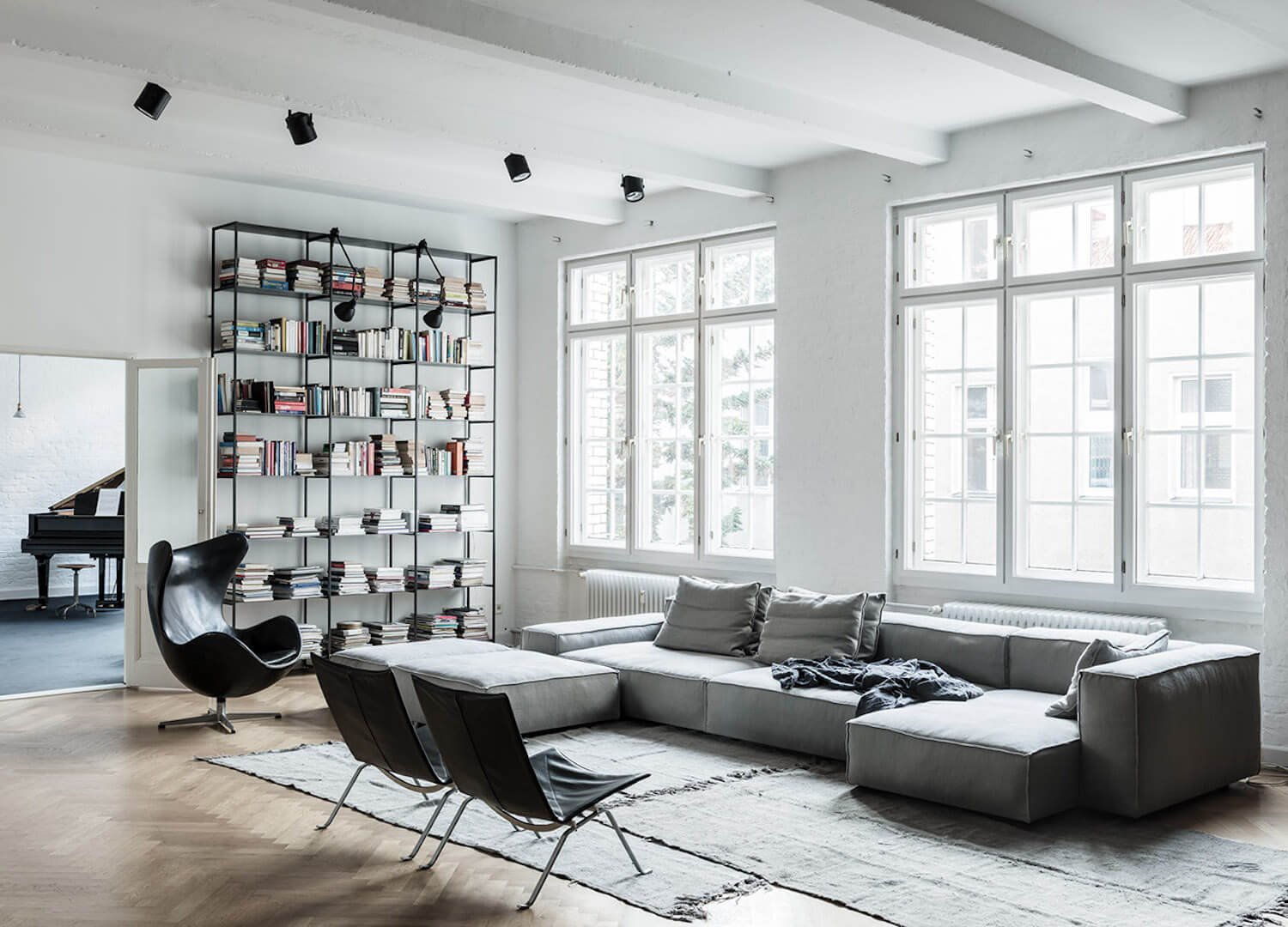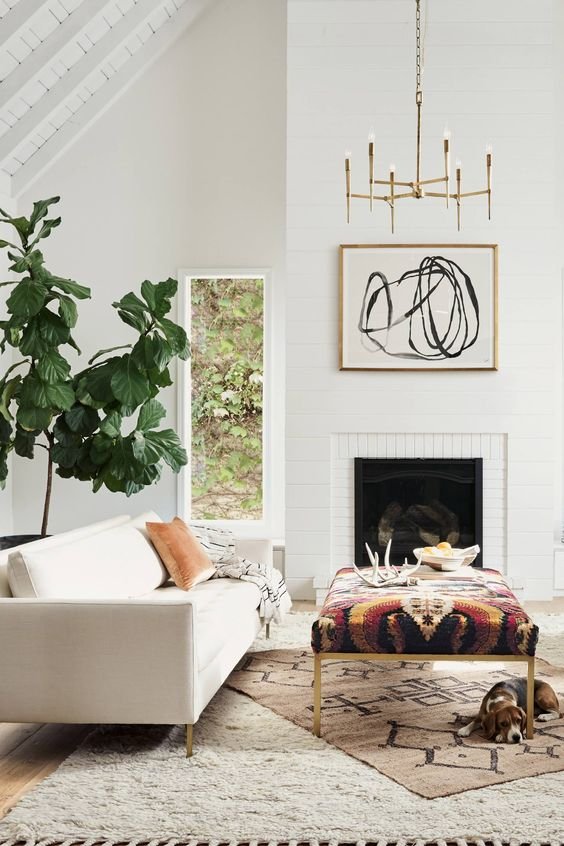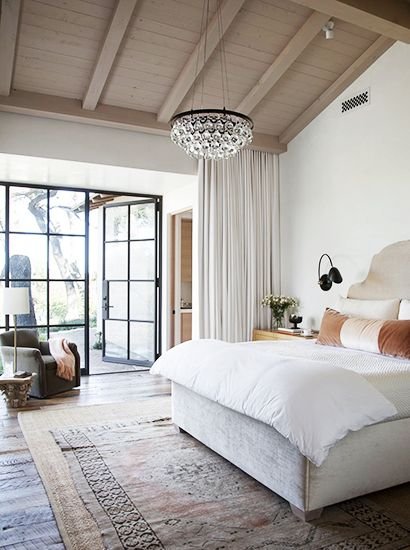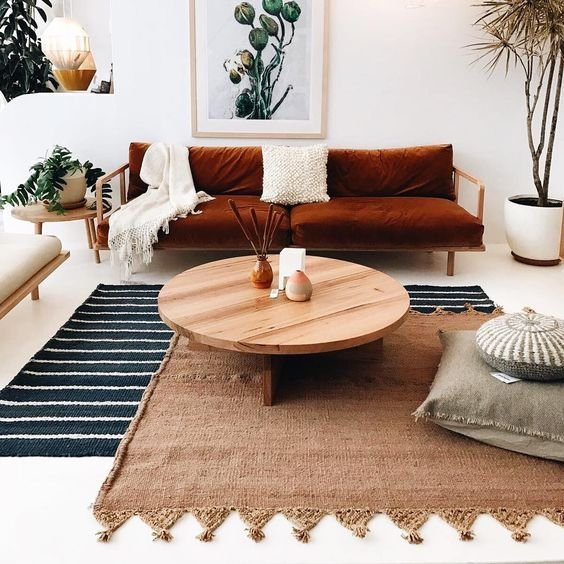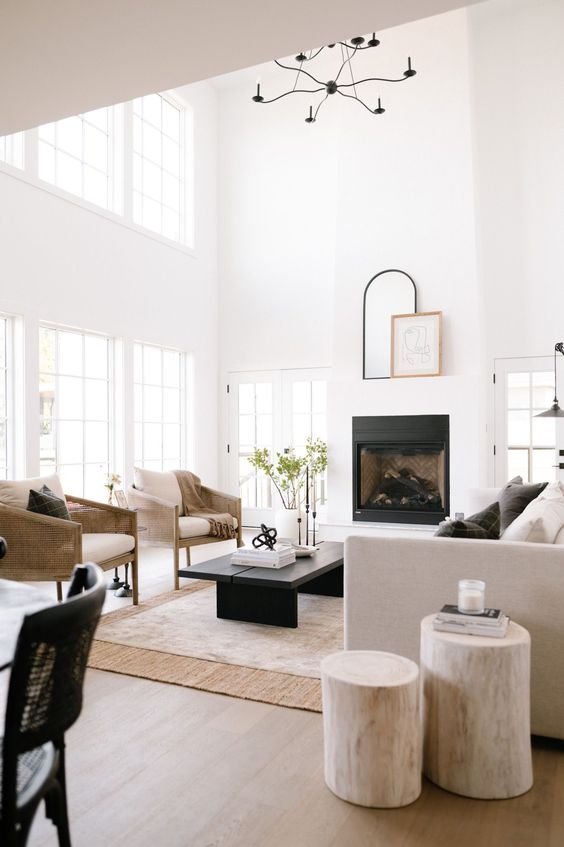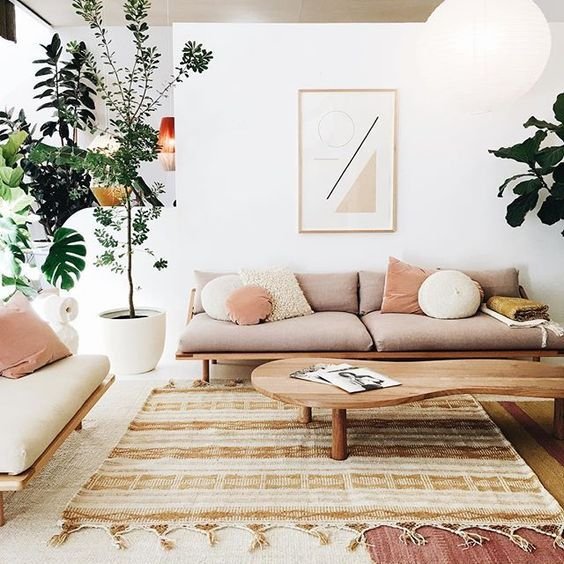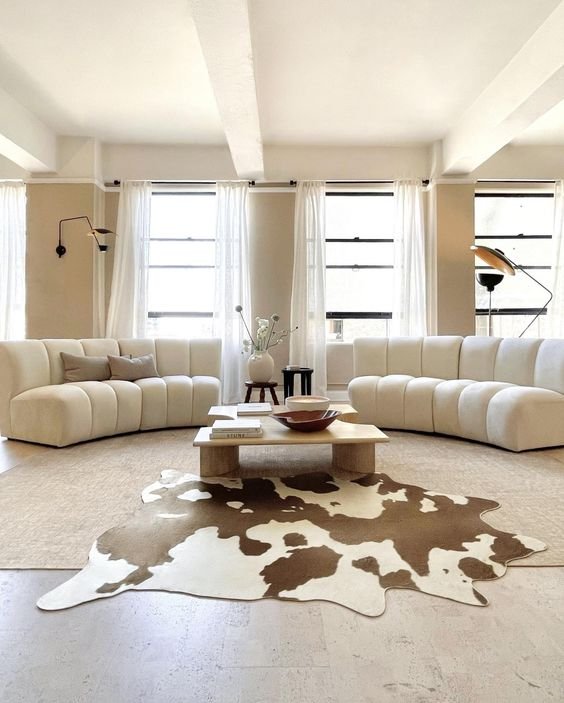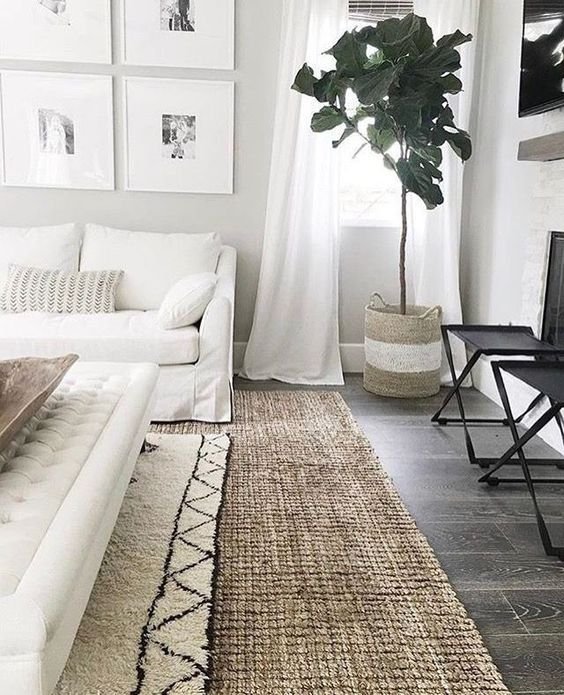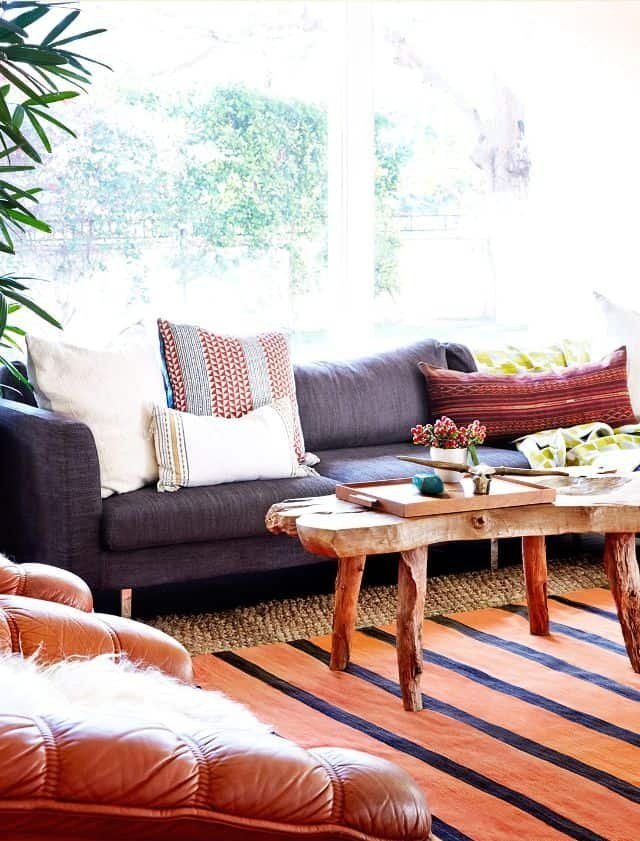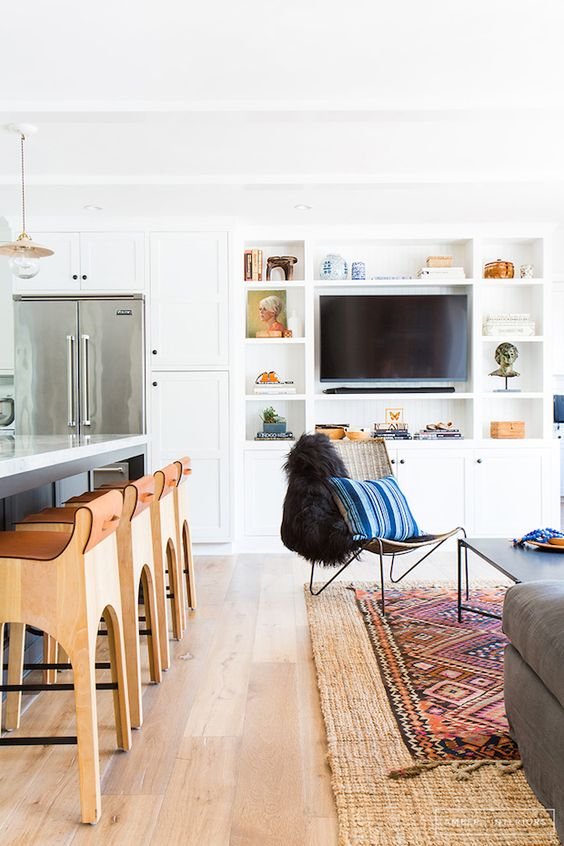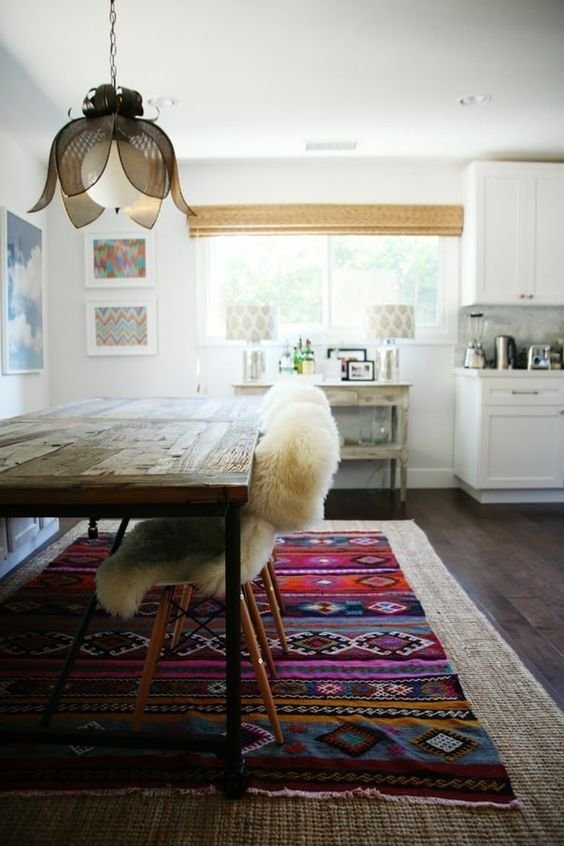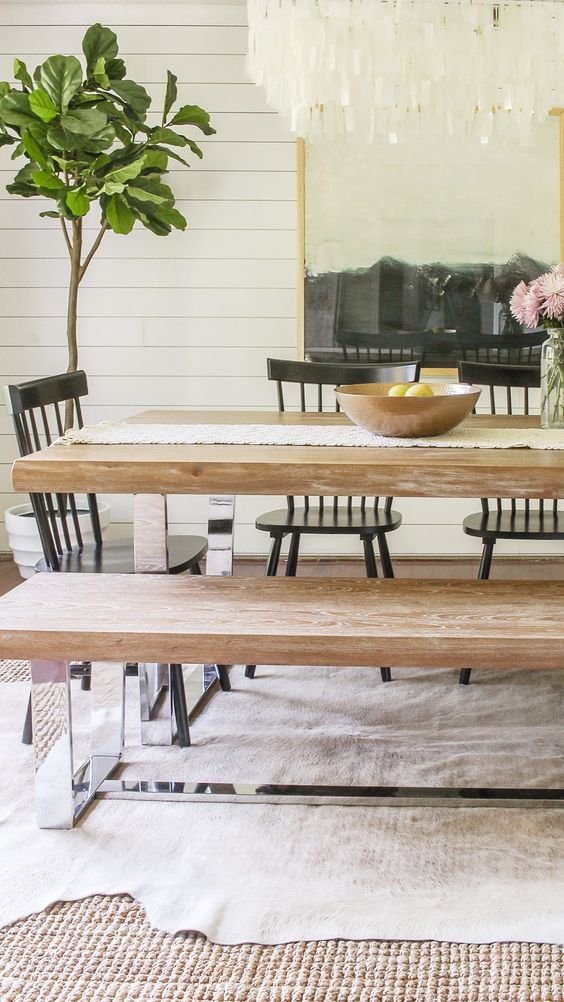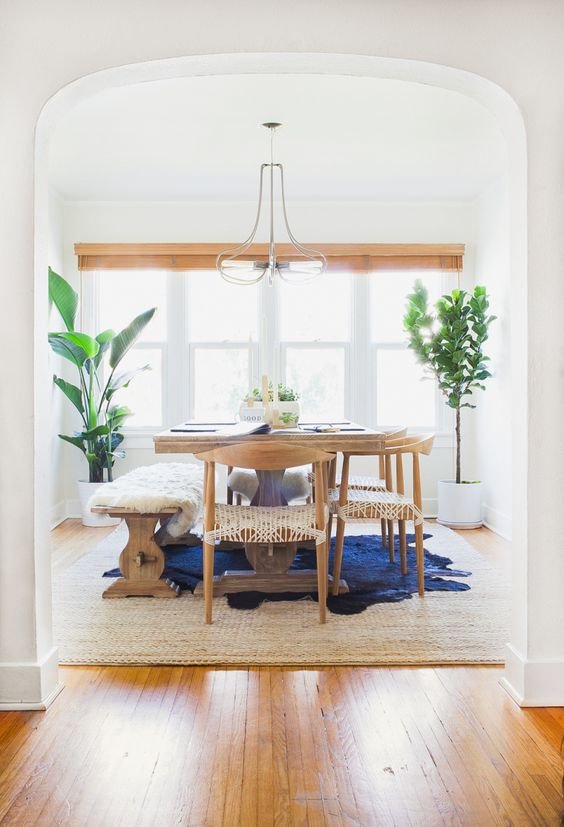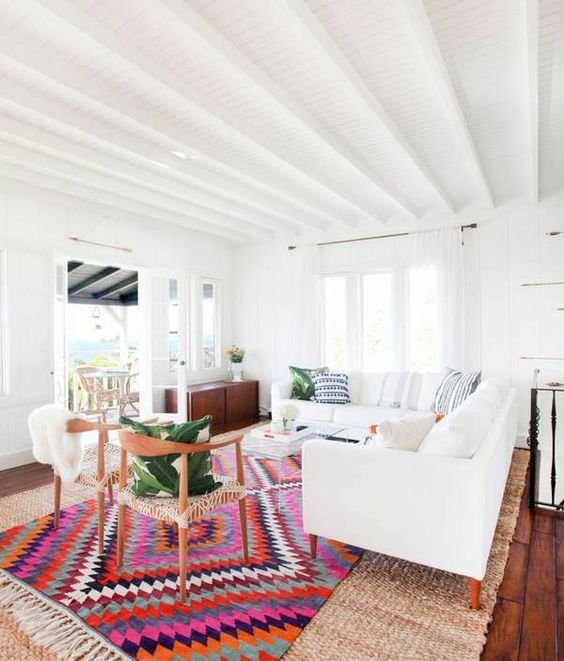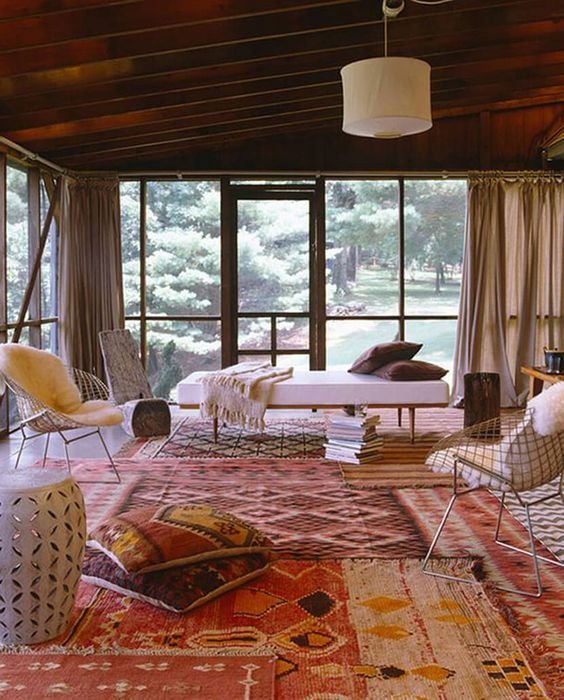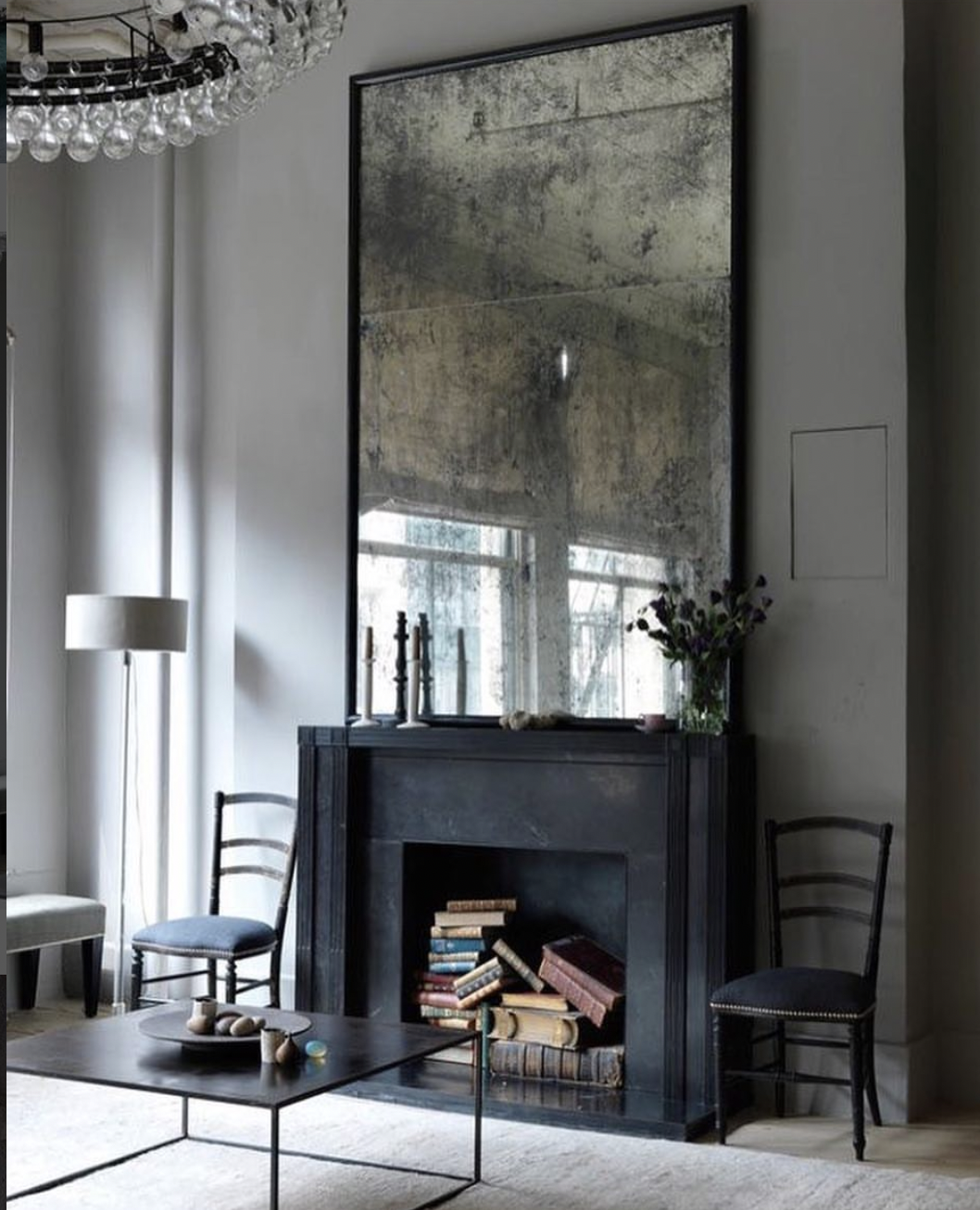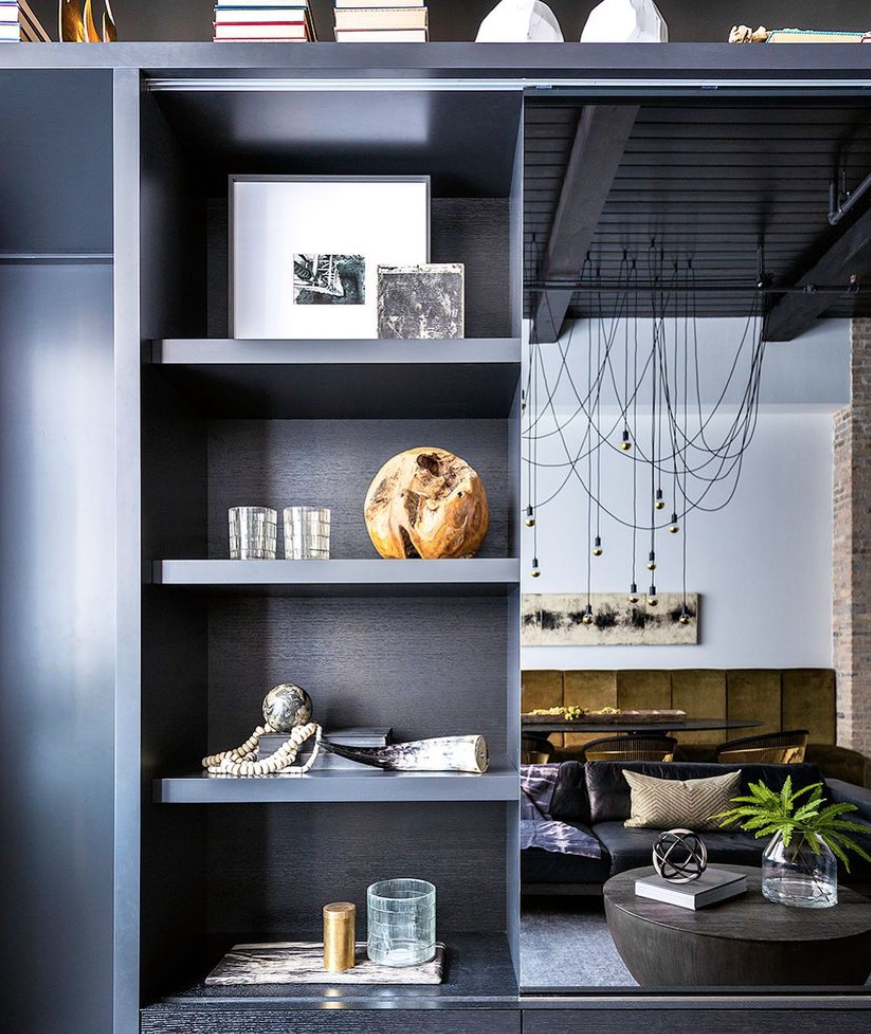LAYER UP - A Simple Guide To Layered Rugs.
Join us on a journey of rug layering mastery, where we'll guide you through the ins and outs of selecting the perfect sizes, coordinating colors, and pairing patterns like a pro. No corner of your home will be neglected as we explore the art of layered rugs in living rooms, dining rooms, and those cozy in-between spaces that deserve a touch of undeniable style. And fear not, and we'll spill the beans on the best places to shop for those jaw-dropping rugs that will make your heart skip a beat.
You may have noticed this trend gaining popularity in recent years, and for good reason. Layered rugs can easily transform a room without overpowering the overall design. It allows us to experiment with rugs of different sizes, shapes, and materials while distinctively showcasing our personal style. One of the best aspects of layering rugs is their adaptability - we can apply this approach to any room, from a small bedroom to a spacious living area.
Let's get back to design basics to start our rug layering journey. Generally, we can layer two or three rugs at a time, but we think that two is the sweet spot. Design crime alert; be mindful not to go overboard with too many colors or patterns, which could create visual chaos. With a solid foundation and the right combination of rugs, we can effortlessly elevate our living spaces with the art of layering.
Benefits Of Layered Rugs
Adds Dimension, Depth & Texture
Layered rugs are an excellent way to add texture, dimension, and depth to our home. Using rugs of different sizes, materials, and textures, we can create a visually interesting and dynamic floor that complements our furniture and other décor elements.
One way we love to amp up the design game is to select rugs that have contrasting textures. Using rugs with different textures creates visual interest and contrast in a space. For example, layering a natural woven rug (such as a sisal rug) with a soft plush rug or a short-pile rug with a thicker shag rug. Combining rugs with different textures can add subtle depth and dimension to your living room while maintaining a cohesive and stylish look.
Here's the secret, the rugs should be noticeably different in some way. Start with a solid natural rug, which usually has multiple color tones. It sets the foundation of your design so that you can add rugs made of another material or different colors on top.Our in-house Interior Designer suggests mixing a short pile rug paired with a plush shaggy rug or a velvety soft pile rug layered on a thin woven rug. Now, if you're going for a chunky, natural weave for the bottom rug, choose a thin and soft rug to go on top.
Pulls A Room Together & With Color And Pattern
The layered look allows us to experiment with various patterns, colors, and textures. This is an opportune way to introduce new palettes and motifs into our spaces without committing to bigger changes like repainting walls or purchasing new furniture. By layering bright, patterned rugs with more neutral or subdued tones, we can easily add interest, depth, and character to our rooms while maintaining an overall cohesive aesthetic.
Here's a pro tip to achieve rug layering perfection: start by examining the existing elements in your living room. If you have a statement wallpaper, pair a neutral base rug with a patterned rug featuring a different scale. This creates a harmonious balance and a seamless transition between the two. Not only will it beautifully complement the wallpaper, but it will also inject a burst of color into your space, taking the ambiance to a whole new level. Don't forget to pull colors from other elements in the room, like throw pillows, artwork, or decor items, to tie everything together in a cohesive and eye-catching way. Protect Hardwood Floors & Define A Space
Area rugs help to protect our floors and define specific zones within our living areas. By placing a rug on top of wall-to-wall carpet or over another existing old rug, we can enhance the longevity of our flooring and create clear boundaries for individual zones like sitting areas, dining spaces, or reading nooks. Additionally, rug pads can be utilized for added safety (avoiding trip a hazard) and comfort, making our layered rugs more enjoyable for daily use.
Cost Savings
Now, you might be wondering: is buying two rugs more expensive than buying just one? Well, not necessarily. Let's talk about the price game regarding those fabulous floor coverings. We all know high-quality wool area rugs with intricate patterns can put a dent in your wallet, while plain rugs are generally more budget-friendly.
But here's a nifty hack: instead of splurging on a huge patterned rug, why not layer a smaller one on top of a larger plain rug? It's a smart, cost-friendly move that adds visual interest and keeps your wallet happy.Choosing the Right Rugs
Selecting Materials & Textures
When it comes to layering rugs, we first need to consider the materials and textures. Mixing textures can create an interesting and visually appealing look in any space. A neutral rug is a great base for layering, allowing us to play with textures, patterns, and colors on top. One popular option is using a jute rug as the base layer, as it offers natural texture and durability.
For the top layer, we can experiment with different materials like faux cowhide, sheepskin, or patterned flat-weave rugs. Cowhide is popular, adding an organic shape and interesting texture to the neutral base rug. Here are some materials and textures to consider when layering rugs:
Natural fibers (jute, sisal)
Faux cowhide
Sheepskin
Patterned flat-weave rugs
Mix Solid Styles With Patterned Rugs
When it comes to perfecting the layered look with area rugs, nailing the coordination of different patterns, prints, or colors is the name of the game. There are no rules, but mix solid styles with patterns, and You want those colors that work well together with similar tones and shades that create a seamless and unified design. This careful color coordination ensures that your rug layering looks intentional and avoids any "what on earth were they thinking" moments. And let's not forget about patterns. They can work wonders in bridging the gap between your rugs.
Now, if you're like us and aiming for a more refined and laid-back vibe, go for solid or neutral colors while experimenting with different textures to add interest. The most successful layering, in our opinion, is a vintage patterned rug (for example, Persian) combined with a natural woven jute rug. We steer clear of the pattern-on-pattern look, as it feels too colorful and busy for our taste. Considering Size & Price
Another important factor to consider when purchasing rugs is the size and price. We want to ensure we choose the best size for the space while keeping the overall cost in mind. Start by measuring the area where we plan to layer the rugs. A larger rug works as the base, while a smaller one goes on top, creating a layered look.
Keep in mind that the top rug should be proportional to the base rug, not covering it entirely. Leave some breathing room around the rug on top. Think of it as giving it a decent-sized border or a picture frame. And for that perfect proportion, aim for the top rug to be around two-thirds the size of the bottom rug. It's like a rug-layering math lesson but way more exciting.
When it comes to pricing, area rugs can vary greatly depending on the materials and quality. It's possible to save money by selecting more budget-friendly materials for the base layer, such as jute or sisal rugs, and investing in a smaller, higher-quality rug for the top layer.
We recommend exploring small business brands for unique and affordable area rugs. By carefully considering the materials, textures, size, and price, we can create a beautiful and functional layered rug look in our space.
Layering Rugs in Different Rooms
Get ready to layer rugs to create a cozy feel in your home. We'll cover living rooms, dining rooms, and even outdoor patios. Let's dive in.
Layered Rugs In Living Room
In the living room, layering rugs can provide added style and comfort. Interior Designers often use a rug to deal with the issue of "floating furniture" in a large seating area. One approach is to choose an area rug size that covers more floor space. We recommend leaving a 10 to 20 inches gap between the edges of the rug and the room's walls, with all furniture pieces (couch, chair, coffee table.....you get the drift) resting on that one rug that covers most of the floor space, ideally in a neutral or solid color.
We can then add a smaller, patterned rug on top, positioning it underneath the furniture to create a defined seating area. Don't forget to mix patterns and textures to add interest while keeping the overall design cohesive.
Consider choosing a large solid-color base rug.
Layer a patterned rug on top.
Arrange the smaller rug under the seating area.
Layered Rugs In The Dining Room
The dining room is another space where layered rugs can take your design to the next level. Here, we can start with a flat-weave or low-pile rug as the base layer, ideally large enough to extend beyond the dining table and chairs. Make sure your rug is large enough. Your rug should be big enough to accommodate the table and all your chairs when they are pulled out. Usually, this means adding 24 to 30 inches from each edge of the table when it is fully extended (don't forget to account for table leaves if you have them!)
Next, we can add a smaller decorative rug underneath the table to create contrast and showcase your style.
Use a flat-weave or low-pile rug (like a sisal rug) as the base layer
Layer an accent decorative rug under the dining table
Ensure the base rug extends beyond the table and chairs
Layered Rugs On Patios
For outdoor spaces like the patio, layering rugs is an excellent way to kick bring indoor comfort outside and create inviting seating areas. Choose a durable, all-weather base rug that can withstand the elements, such as an outdoor sisal or jute rug. We can then add colorful or patterned outdoor rugs on top, anchoring them with outdoor furniture or placing them in conversational zones for a more cohesive look.
Select a durable, all-weather base rug.
Add patterned or colorful outdoor rugs on top.
Arrange rugs under outdoor furniture or conversational zones
Tips For Successful Rug Layering
Match Patterns and Colors
When layering rugs, it's essential to ensure the patterns and colors work well together. Playing with contrasting patterns or blending similar patterns is great for creating a cohesive look. For instance, pairing a bold red rug with a vintage-style patterned rug can add depth and visual interest to your space. Remember not to get carried away – finding the right balance between minimal and elaborate elements is key. Or go big or go home and opt for a selection of rugs all in the same color palette as the living room below.
Use Rug Pads For Stability
Adding rug pads under your rugs provides a stable base and prevents the rugs from slipping or bunching up. They also offer extra cushioning for added comfort. Rug pads work with various rug materials, so it's not a problem if you're mixing different materials, like a jute rug atop a plush rug. A bonus benefit is that rug pads can also protect your floors and rugs from stains and wear.
Experiment With Furniture Arrangement
Feel free to explore various furniture arrangements around your layered rugs. To create a comfortable and visually balanced space, try keeping at least two of your furniture legs on top of the rugs. For example, you can use a large rug to cover the main floor area, then place a smaller rug at an angle or slightly off-center, effectively placing furniture on both rugs. This approach lets you play with the arrangement, finding what looks best in your space.
Remember not to make exaggerated claims or force certain aspects. Instead, make informed decisions that reflect your style preferences, ensuring a beautiful and functional rug layering result.
Popular Rug Combinations
Layering rugs is a fantastic way to add depth and texture to your living space. In this section, we'll explore some popular rug combinations that you can try in your home.
Jute Rug Layering & Patterned Rugs
One combination we love is layering rugs over jute. The natural, earthy tones of jute rugs provide a perfect backdrop for patterned rugs with vivid colors or intricate designs. Start by laying the jute rug as a base, and then place the patterned rug on top. Doing this creates a visually appealing contrast between the textures and patterns.
Some benefits of this combination include:
Jute rugs are durable and eco-friendly
Patterned rugs can add a pop of color and visual interest to the room
The mix of textures creates a sophisticated look
Cowhide & Area Rugs
Another popular combination is layering a smaller cowhide rug over an area rug. Cowhide rugs deliver a unique and stylish element to any room, while area rugs can tie the entire design together. This combo works particularly well in spaces with wall-to-wall carpeting, as it adds an extra layer of dimension.
Some advantages of this combination are:
Cowhide rugs are soft and luxurious
Area rugs come in various materials, patterns, and colors
The layering adds a touch of warmth and comfort to your space
Solid & Vintage Rugs
Lastly, if you're aiming for a more classic and timeless look, consider layering a solid rug with a vintage rug. The solid rug acts as a canvas for displaying the beautiful details and colors of the vintage rug. This combo works best in rooms with simpler designs or where you want the vintage rug to truly shine.
Some perks of this combination include:
Solid rugs can effortlessly blend with any decor style
Vintage rugs offer a unique design that adds character to the space
The combination creates a harmonious balance between bold patterns and simplicity
In summary, these popular rug combinations offer endless opportunities for personalizing your space. Experiment with various materials, patterns, and textures—you might be surprised by the stylish results!
Where to Buy Layered Carpets
Online Retailers
Are you ready to level up your interior design game and find the perfect modern-quality rugs? Look no further! We've curated a list of the best places that will elevate your space to new heights. Whether you're searching for contemporary designs, luxurious textures, or unique patterns, these trusted online retailers have covered you.
Armadillo & Co - Experience sustainable, handcrafted rugs combining timeless elegance and ethical practices.
Dash and Albert - Discover versatile and durable rugs that effortlessly blend style and functionality in any space.
The Citizenry - Explore ethically sourced rugs crafted by artisans worldwide, offering unique designs and rich cultural heritage.
Lulu and Georgia - Browse a curated selection of modern rugs, from handwoven masterpieces to chic and trendy designs.
ABC Carpet & Home - Explore a selection of artisanal rugs that showcase craftsmanship and cultural richness.
Anthropologie - Indulge in bohemian-inspired rugs with artistic flair and captivating patterns that will transform any room.
Rugs USA - Experience a wide range of modern rugs at affordable prices, from trendy designs to timeless classics.
Our rug layering adventure has shown us the incredible power of infusing color, pattern, and texture into our living spaces. We can achieve that cozy, lived-in atmosphere we all desire by following a few key tips. Placing distinct rugs beneath each furniture piece not only adds visual appeal but also protects our floors. Additionally, layering rugs helps unify a space, especially when incorporating recurring color themes. Don't hesitate to mix patterns and materials for a dynamic and diverse look.
Remember, scale and proportion are key when layering rugs. So, let your creativity soar and embrace your unique style. Don't be afraid to experiment with different rug combinations until you find the perfect mix that takes your home decor to new heights. With these insights in hand, let's embark on a rug layering journey and give our spaces the cozy and stylish upgrade they truly deserve!I
GATHERAUS - where your dream home décor comes to life with endless style inspiration. Scroll and click those links below and watch your living space go from drab to fab in a snap.
